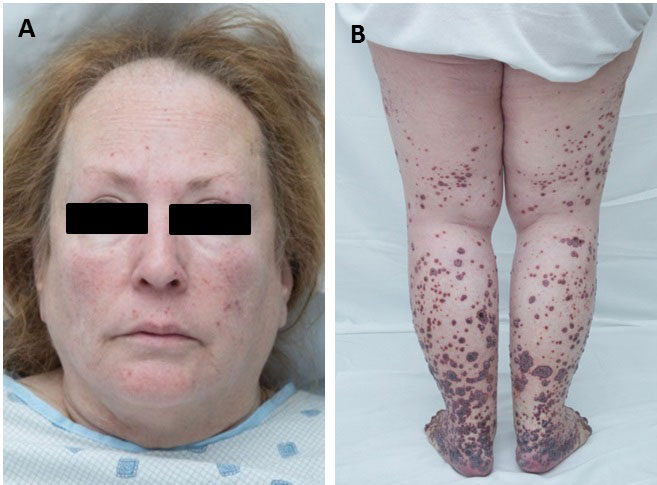Session Information
Session Type: Poster Session (Monday)
Session Time: 9:00AM-11:00AM
Background/Purpose: IgA vasculitis (IgAV) is an immune-complex mediated, small-vessel vasculitis which predominantly involves the skin on the lower extremities. Head and neck involvement is rarely reported. The purpose of this study was to describe the presentation and outcome of a series of patients with head and/or neck involvement in comparison to patients with cutaneous findings isolated to the lower extremities.
Methods: Patients with biopsy-proven IgAV from January 1, 1997 through December 31, 2016 were retrospectively identified through direct medical chart review. IgAV was diagnosed in accordance with the American College of Rheumatology (ACR) and the European League Against Rheumatism/ Paediatric Rheumatology European Society/Paediatric Rheumatology International Trials Organisation (EULAR/PRINTO/PRES) criteria. Among this cohort, patients with documented clinical, photographic, or histologic descriptions of vasculitic skin lesions affecting the head or neck were compiled. Each patient with head/neck (H/N) involvement of IgAV (case) was matched to two age- and sex-matched control patients with IgAV for which the cutaneous features were isolated to the waistline or distal. Baseline characteristics, laboratory parameters, treatments and outcome were collected by a physician abstractor.
Results: Thirteen patients with H/N-IgAV involvement were identified. Baseline characteristics of the cases and controls are demonstrated in Table 1. H/N involvement included facial (cheeks, forehead) [n=6], perioral/oral/lip [n=6], auricular [n=2], nasal [n=2], and neck [n=1]. All patients in both groups had evidence of purpuric skin lesions. Patients with H/N-IgAV involvement more frequently had evidence of skin ulcerations (23% vs. 0%; p=0.01) [Figure 1]. Overall baseline renal involvement and microscopic hematuria were less commonly observed in patients with H/N-IgAV. Among H/N-IgAV cases, at last follow-up all had resolution of H/N lesions but 3 of 13 had persistent skin lesions on the lower extremities despite ongoing treatment. Long-term outcome between cases and controls did not identify any significant differences in the development of end-stage renal disease, time to resolution of hematuria or proteinuria, time to complete IgAV response, or time to first IgAV relapse.
Conclusion: This study reports the largest series of patients with head/neck involvement of IgA, a rarely reported entity. In this cohort, patients with H/N-IgAV had less frequent renal involvement compared to IgAV patients with lower extremity only skin lesions. Clinicians should be aware of atypical locations of IgAV involvement. Additional research is needed to further understand this clinical subset.
To cite this abstract in AMA style:
Villatoro-Villar M, Wetter D, Crowson C, Warrington K, Koster M. Head and Neck Involvement of IgA Vasculitis: A Case-Control Study [abstract]. Arthritis Rheumatol. 2019; 71 (suppl 10). https://acrabstracts.org/abstract/head-and-neck-involvement-of-iga-vasculitis-a-case-control-study/. Accessed .« Back to 2019 ACR/ARP Annual Meeting
ACR Meeting Abstracts - https://acrabstracts.org/abstract/head-and-neck-involvement-of-iga-vasculitis-a-case-control-study/


